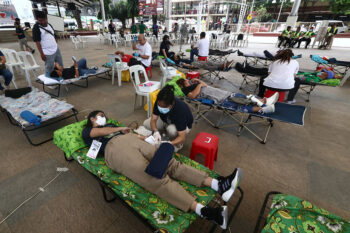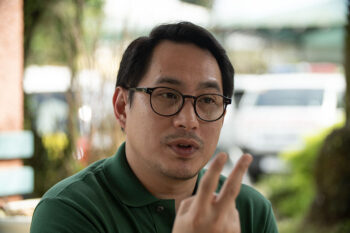GENERAL SANTOS CITY, October 1, 2013 – Three reports offer significant facts and insights to peace watchers and decision-makers in relation to the Zamboanga City “war” or “crisis” three weeks after it had started last September 9. Manila media reports may provide the drama. But these three Zamboanga-based reports contain the keys to understanding the plot and the resolution.
This is so as Malacanang “officially” declared the Zamboanga crisis “over” last Saturday (Inquirer.net, September 28, 2013: Palace confirms Zamboanga crisis is over) even as Defense Secretary Voltaire Garcia said in another Inquirer story it really “ain’t over yet” with mopping up operations still going on. And, for Zamboanga City Mayor Isabelle Climaco-Salazar, the crisis will continue through an indeterminate period of returning the evacuees, rehabilitation and reconstruction.
The Reports
The reports and what they offer:
“The Zamboanga Crisis: Some Searching Notes”, by Grace Jimeno-Rebollos, Ph. D., a university professor, former president of Western Mindanao State University and regional convenor of the Western Mindanao Cluster of Bantay Bayanihan, presents the views, observations and efforts of civil society towards a “peaceful” or “win-win” resolution of the Zamboanga crisis – tersely, “Silence the guns, save lives”, as stated in the September 14, 2013 “Statement of the Interreligious Solidarity for Peace”.
“Zamboanga City standoff: more deaths, more ‘bakwits’” and “Standoff could have ended on Day 5, Sept. 13 if …”, both datelined “Zamboanga City, September 25” and posted in MindaNews September 26 were written by Mindanews editor, Carolyn O. Arguillas, who covered the crisis on the scene . They present the casualties and damages of the “war” and the clash of options that explains the state of the crisis.
Taken from the reports of the National Disaster Risk Reduction and Management Council (NDRRMC) with September 22 as the cut-off date, the figures in these reports will differ from the latest, as of September 28, but the significance remains the same – the immensity of the tragedy that raises questions on the necessity of the MNLF action and the conduct of resolving the crisis.
The latest figures on casualties and damages as updated on September 28 are in parentheses following each category of the NDRRMC figures. Discrepancies are expected. These, however, should not diminish the significance.
Casualties and Damages
Both Rebollos and Arguillas presented the casualties and damages which the latter showed in graphs as of September 25 in four categories.
I. Killed, cumulatively, as of September 13, 14, and 22: (1) Police: 3, 3, 3; (2) Military: 2, 2, 11; (3) Civilians: 2, 3, 10; (4) MNLF: 11, 43, 80. On September 13, the total number killed was 18, more than half, MNLF; on the day after, this almost tripled, five of eight, MNLF; eight days after, this rose to 104, four of five, MNLF.
[Inquirer.net, September 28: Nearly 200 were killed, with 166 of them rebels and 23 from combined security forces. Inquirer Mindanao: 199 – 18 soldiers, 5 policemen, 12 civilians, 167 MNLF. NDRRMC (Sept. 28: 137 – 5 policemen; 18 military; 9 civilians, 105 MNLF. ]
II. Wounded, cumulatively, as of September 13, 14, and 22: (1) Police: 6, 12, 13; (2) Military: 28, 38, 131; (3) Civilians: 18, 28, 48; (4) MNLF: 52, 78, 192. On September 13, the total number wounded was 52, one of three, MNLF; on the day after, this rose to 78, still one of three, MNLF; eight days after, the total was 192 – increasing by almost 150 percent — one of four, MNLF.
[Inquirer Mindanao, September 28: Wounded 253 – 167 soldiers, 14 policemen, 72 civilians. No figure of MNLF wounded. NDRRMC (Sept. 28): 241 – 15 policemen; 169 military; 57 civilians.
No figure for MNLF.]
III. Displaced, cumulatively, as of September 13, 14, and 22: The number 23,584, on September 13, increased more than three times to 82,329 on the next day; and, more than four times to 109,286 on September 22. Rebollos’ figure of 126,407 evacuees differs from Arguillas’ figure two days earlier. However, what’s significant is that against Zamboanga City’s population of 807,000, the displacement is roughly one out of eight.
[Inquirer Mindanao: More than 100,000 residents; NDRRMC (Sept. 28.118,119.]
IV. Economic Losses, in three sectors as ofs September 25: (1) retailing/trading, P68 million; (2) manufacturing, P634 million; (3) servicing, P64 million. Obviously, these were estimates which totaled to P763 million.
[Inquirer.net: About P5 billion were reportedly lost in trade and commerce in the last three weeks.]
V. Houses burned: The estimated 500 on September 14 rose to 10,160 on September 22. [No change as of September 28]
[Inquirer Mindanao: Officials counted at least 9,532 houses destroyed.]
According to Arguillas, the NDRRMC on September 19 estimated that P3.89 billion would be needed for rehabilitation. The estimate covered only a 10-day period. As the crisis, including burning, may go beyond three weeks, the amount will be much more.
Could all these have been avoided?
The question evokes the clash of options between the Zamboanga City civil society and peace advocates on one hand and the government and the military on the other; it also highlights two “IFs”, one taken for granted and the other rejected.
Taken For Granted
The MNLF “invasion” had been planned and could have been preempted as the first option. That this option was taken for granted is evident from the Rebollos report:
Item 1. “The security sector claims to have possessed intelligence information on the entry of threat elements into Zamboanga City and the massing up of firearms being landed through coastal barangays. These would have easily pointed to the possibility of an attack.”
Item 2. “Over the last few months, the sale of motorcycles with XRM engines rose so suspiciously high. One hypothesis is that since these engines could also be convertible to pump boat engines, they can give more access and mobility by sea.”
Item 3: “Late Sunday night, prior to the early Monday raids, men in civvies were uncharacteristically massing up and loitering along the boarding houses of Lustre and other places in Sta. Barbara. They donned their uniforms by early dawn and bore long high powered firearms that had red ribbons tied to their barrels.”
Without directly saying so, the Report blames the “intelligence sector” for not conducting “raids” based on its information “to forestall” preparations for the attack. That the MNLF fighters were able to assemble armed and in uniform in early dawn of September 9 for their so-claimed “peaceful march” to the city hall showed how soundly the “intelligence sector” had been sleeping – a very, very costly sleep.
Negotiation Rejected
On the suggestion of hostaged priest, Fr. Michael Ufana, a native of Zamboanga City, MNLF Commander Ustadz Habier Malik agreed to a peaceful end of the standoff with the priest conveying his conditions to government authorities and the military. That was the second option that, in baseball lingo, never reached first base.
Ufana’s statements were taken by the police and he met the mayor.
That was Friday morning, September 13, the day President Aquino arrived in Zamboanga. By the way Ufana was received, the government authorities and the military were not interested to negotiate on Malik’s terms. They were not interested to hear the MNLF grievances as told to Ufana by Misuari in a phone conversation facilitated by Malik.
As Arguillas reported, Malik’s demands were: (1) a ceasefire for the facilitation of the release of the hostages; (2) safe passage for the MNLF rebels to leave Zamboanga City back to their home places in Sulu and Basilan; and, (3) an ambulance for the disabled – obviously, sick or wounded – hostages.
This was the “Cabatangan formula” or “Cabatangan template” that the MNLF forces under Misuari’s brothers used in November 2001 when they barricaded themselves in the ARMM compound in Cabatangan, also in Zamboanga City with 60 hostages. With that “win-win” solution, the rebels safely left the city without further casualties on their part and the military – with no harm to the hostages and damages to the city.
This was what the city civil society and peace advocates had wanted to happen – “silence the guns and save lives”. But they could only rue with the two “IFs”: IF the “intelligence sector” only preempted the attack; IF the government and the military only granted Malik’s demands, the deaths, destruction and probable damage to inter-cultural or Christian-Moro understanding and solidarity could have been prevented.
The Only Option
But the national government and the military could only agree to another type of negotiation. That was, the MNLF rebels must, first, free their hostages and, second, surrender unconditionally. That they had committed a crime against the state and the people they must face justice. If they don’t, they will be annihilated – the only option.
No! Not “silence the guns and save lives” but “crime and punishment” is the response of the national government and military to the plea of the city civil society and peace advocates. There was the clash of options, the clash of priorities.
Frencie Carreon, a Zamboanga City journalist, in her report to MindaNews (September 29: Zamboangueños: Crisis far from over) quoted Jay Cabayacruz, a Sunday technical-vocational student expressing in the native tongue the sentiment of Zamboangueños: “No hay sila pensa kay aqui na Zamboanga, puede lang lleba na cuento el problema (They did not think that here in Zamboanga, problems may be addressed through dialogue.”
Carreon observed: “Many Zamboangueños have been expressing disappointment over the way the national government handled the conflict. On social media, the rants have been directed towards Secretaries Roxas and Gazmin.” Besides Cabayacruz, she quoted several others including those from the business and professional sectors.
The Best Option
It was surprising that the government and the military failed to preempt the “invasion” by not acting appropriately on the suspicious signs and movements said to have been detected earlier in the coastal barangays by the intelligence sector and the people. It is known that preemption has always been a military strategy.
That reminds me of Cotabato City in 1974 at the height of the rebellion in the area. City Mayor Teodoro V. Juliano had been asking Cemcom (Central Mindanao Command) to relocate its headquarters since it is the magnet of rebel mortar attacks. Then he and other city officials signed a manifesto to disarm the CHDF (Civilian Home Defense Force) as one of the conditions for the former congressman, Salipada K. Pendatun, to dialogue with the MNLF rebels in coordination with Cemcom.
General Fortunato U. Abat, Cemcom commander, said over the radio that Cemcom could disarm the CHDF then relocate, why not if that was what the city really wanted. But it would come back in full force should the rebels occupy the city (The Mindanao Cross, November 23, 1974). That settled the issue. The Cotabateños were scared. Only Cemcom and the CHDF were preventing the MNLF rebels from entering Cotabato City and preempting its destruction like that in Jolo, Sulu in February that same year.
Preemption is the best option as it ensures humanitarian well being and security. This demands tip-top intelligence, cooperation of the people in the areas concerned and timely, appropriate preemptive actions of government and the military. This evidently failed in Zamboanga City.
“Win-win” negotiation like the Cabatangan formula, the appreciable option, will save lives and prevent wholesale destruction. But it abets “adventurism” to the chagrin and embarrassment of the military and government as shown in the aftermath of the 2001 Cabatangan episode involving the same Misuari MNLF rebels. It is an invitation to a repeat performance, not the final curtain, not a pledge never to come back again.
The military solution – that is, negotiation for unconditional surrender with threat of massive military action should negotiation fail – is the abominable option, the last and only recourse for the government and the military under the policy of justice, crime and punishment when security is seriously threatened.
As a nation, we are very slow to learn from the many costly lessons we have had in the many aspects of our life. In my native tongue, “Kung indi paglinti-an, indi maghulag (If lightning does not strike, we will not move).”
We thrive on paradox. Had Mayor Isabelle Climaco-Salazar asked, before September 9 for national assistance for city development projects, how much could she have been granted? Perhaps, zero for the lack of funds! But after the disastrous military option, the President has made available P6 billion for relief, rehabilitation and reconstruction. (“Comment” is Mr. Patricio P. Diaz’ column for MindaViews, the opinion section of MindaNews. The Titus Brandsma Media Awards recently honored Mr. Diaz with a “Lifetime Achievement Award” for his “commitment to education and public information to Mindanawons as Journalist, Educator and Peace Advocate.” You can reach him at patpdiazgsc@yahoo.com.)







